An Analysis of Finance and Funding in the Travel and Tourism Sector
VerifiedAdded on 2020/10/23
|16
|4006
|340
Report
AI Summary
This report delves into the financial management of the travel and tourism sector, focusing on Carnival Corporation & Plc and Dalata Group Plc. It explores the significance of cost, volume, and profit in decision-making, evaluating various pricing methods such as market-led, cost-plus, and contribution pricing. The report examines factors influencing profit, including seasonal variations, political and economic environments, and current trends. It also covers different types of management accounting information, including budget reports, financial statements, and variance analysis, highlighting their use as decision-making tools. The analysis further includes an interpretation of financial accounts and relevant considerations for the travel and tourism sector.
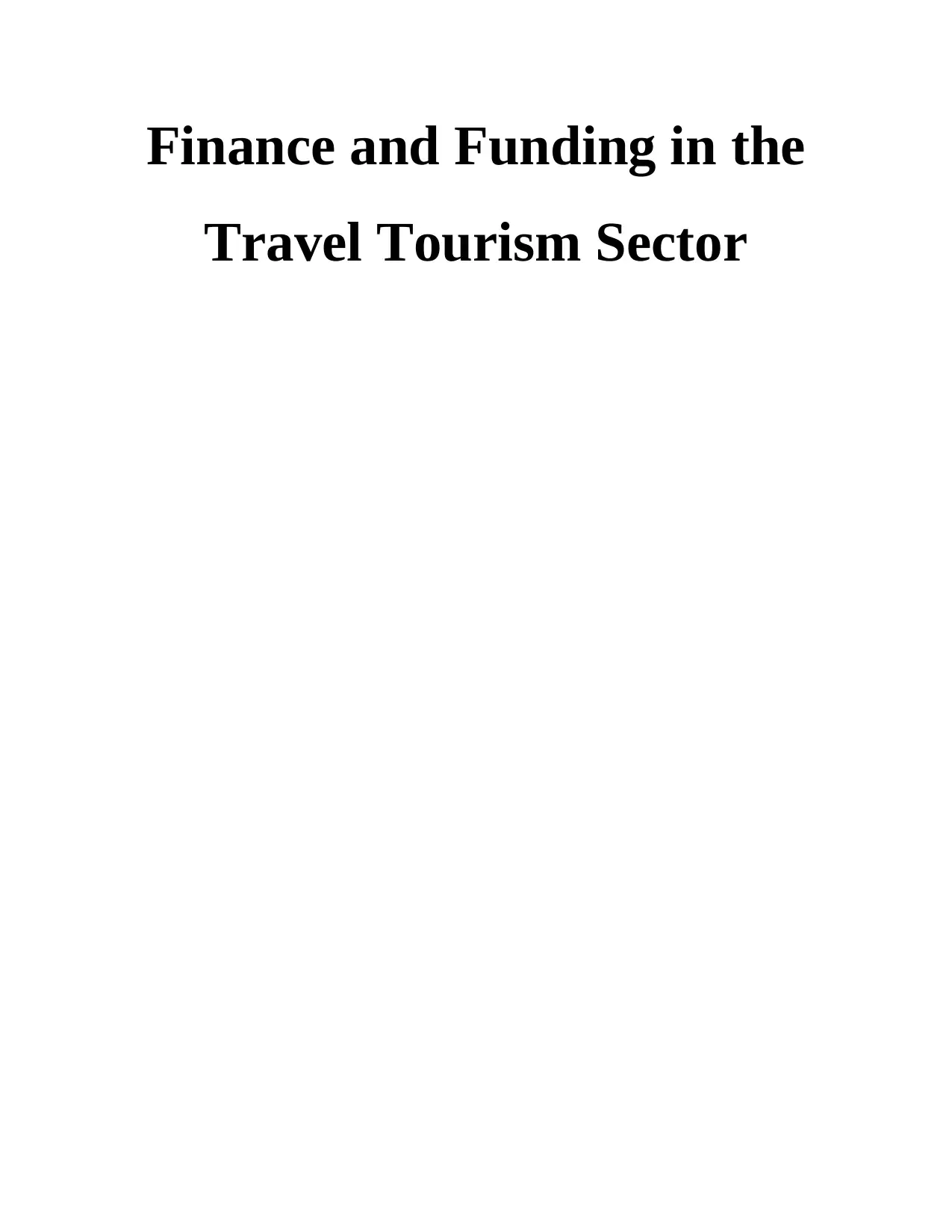
Finance and Funding in the
Travel Tourism Sector
Travel Tourism Sector
Paraphrase This Document
Need a fresh take? Get an instant paraphrase of this document with our AI Paraphraser
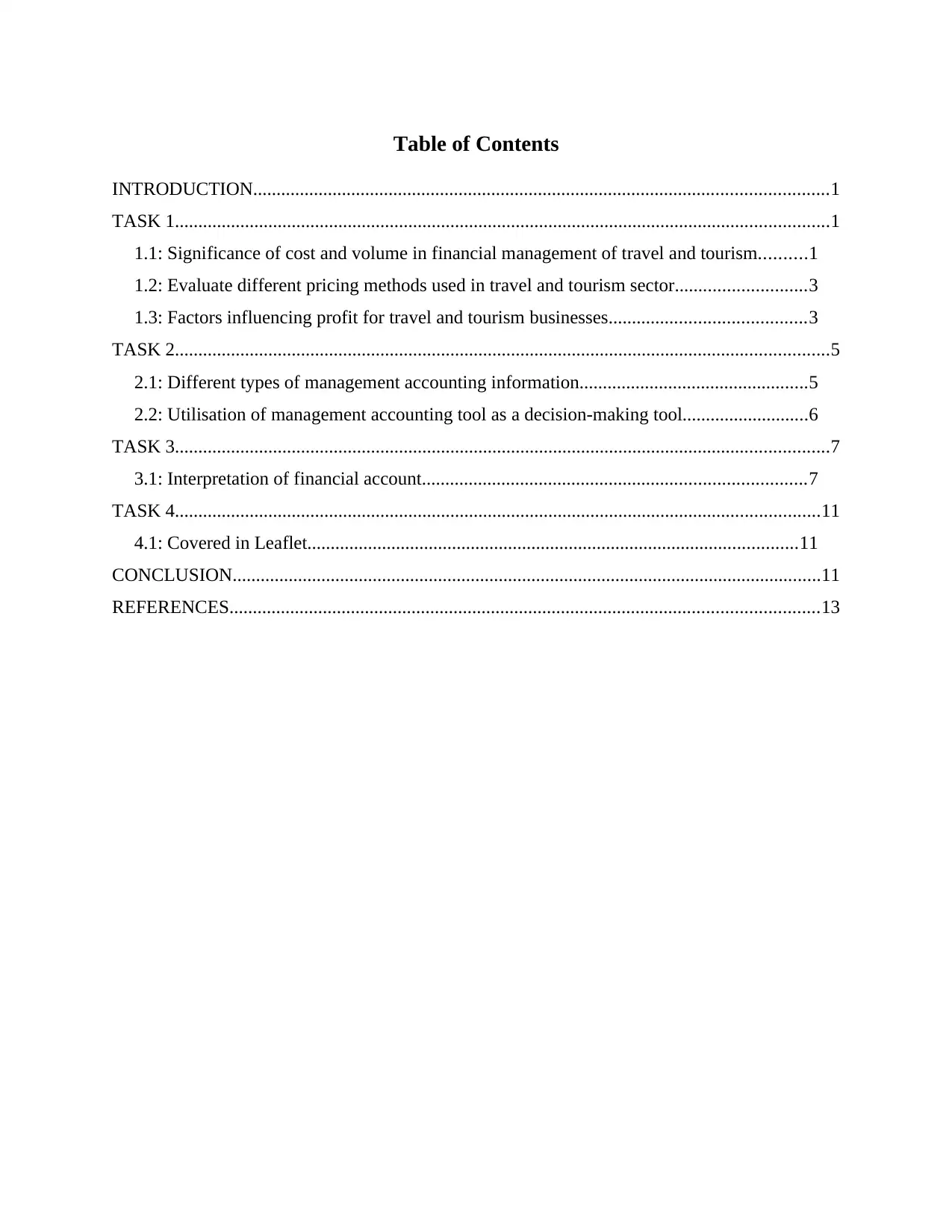
Table of Contents
INTRODUCTION...........................................................................................................................1
TASK 1............................................................................................................................................1
1.1: Significance of cost and volume in financial management of travel and tourism..........1
1.2: Evaluate different pricing methods used in travel and tourism sector............................3
1.3: Factors influencing profit for travel and tourism businesses..........................................3
TASK 2............................................................................................................................................5
2.1: Different types of management accounting information.................................................5
2.2: Utilisation of management accounting tool as a decision-making tool...........................6
TASK 3............................................................................................................................................7
3.1: Interpretation of financial account..................................................................................7
TASK 4..........................................................................................................................................11
4.1: Covered in Leaflet.........................................................................................................11
CONCLUSION..............................................................................................................................11
REFERENCES..............................................................................................................................13
INTRODUCTION...........................................................................................................................1
TASK 1............................................................................................................................................1
1.1: Significance of cost and volume in financial management of travel and tourism..........1
1.2: Evaluate different pricing methods used in travel and tourism sector............................3
1.3: Factors influencing profit for travel and tourism businesses..........................................3
TASK 2............................................................................................................................................5
2.1: Different types of management accounting information.................................................5
2.2: Utilisation of management accounting tool as a decision-making tool...........................6
TASK 3............................................................................................................................................7
3.1: Interpretation of financial account..................................................................................7
TASK 4..........................................................................................................................................11
4.1: Covered in Leaflet.........................................................................................................11
CONCLUSION..............................................................................................................................11
REFERENCES..............................................................................................................................13

⊘ This is a preview!⊘
Do you want full access?
Subscribe today to unlock all pages.

Trusted by 1+ million students worldwide
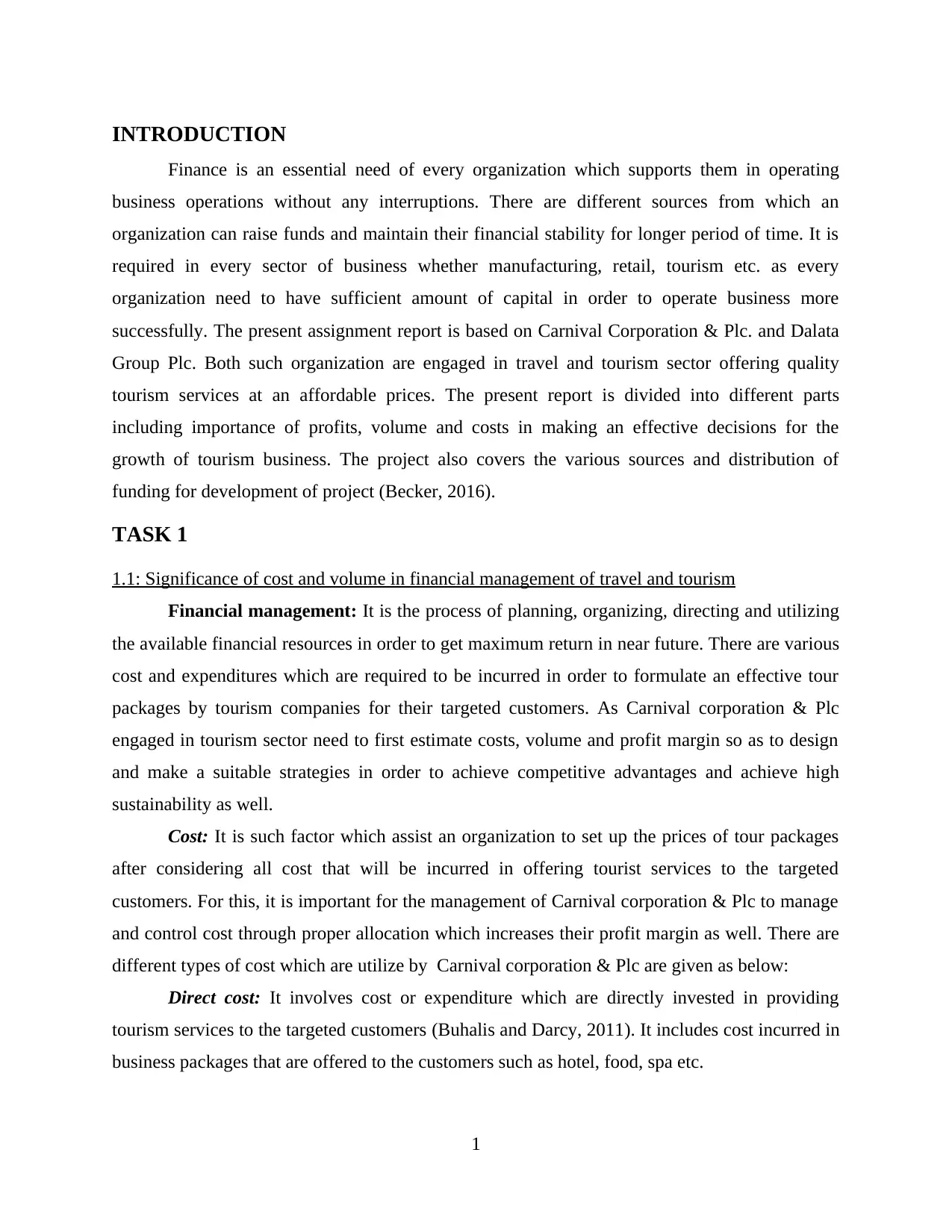
INTRODUCTION
Finance is an essential need of every organization which supports them in operating
business operations without any interruptions. There are different sources from which an
organization can raise funds and maintain their financial stability for longer period of time. It is
required in every sector of business whether manufacturing, retail, tourism etc. as every
organization need to have sufficient amount of capital in order to operate business more
successfully. The present assignment report is based on Carnival Corporation & Plc. and Dalata
Group Plc. Both such organization are engaged in travel and tourism sector offering quality
tourism services at an affordable prices. The present report is divided into different parts
including importance of profits, volume and costs in making an effective decisions for the
growth of tourism business. The project also covers the various sources and distribution of
funding for development of project (Becker, 2016).
TASK 1
1.1: Significance of cost and volume in financial management of travel and tourism
Financial management: It is the process of planning, organizing, directing and utilizing
the available financial resources in order to get maximum return in near future. There are various
cost and expenditures which are required to be incurred in order to formulate an effective tour
packages by tourism companies for their targeted customers. As Carnival corporation & Plc
engaged in tourism sector need to first estimate costs, volume and profit margin so as to design
and make a suitable strategies in order to achieve competitive advantages and achieve high
sustainability as well.
Cost: It is such factor which assist an organization to set up the prices of tour packages
after considering all cost that will be incurred in offering tourist services to the targeted
customers. For this, it is important for the management of Carnival corporation & Plc to manage
and control cost through proper allocation which increases their profit margin as well. There are
different types of cost which are utilize by Carnival corporation & Plc are given as below:
Direct cost: It involves cost or expenditure which are directly invested in providing
tourism services to the targeted customers (Buhalis and Darcy, 2011). It includes cost incurred in
business packages that are offered to the customers such as hotel, food, spa etc.
1
Finance is an essential need of every organization which supports them in operating
business operations without any interruptions. There are different sources from which an
organization can raise funds and maintain their financial stability for longer period of time. It is
required in every sector of business whether manufacturing, retail, tourism etc. as every
organization need to have sufficient amount of capital in order to operate business more
successfully. The present assignment report is based on Carnival Corporation & Plc. and Dalata
Group Plc. Both such organization are engaged in travel and tourism sector offering quality
tourism services at an affordable prices. The present report is divided into different parts
including importance of profits, volume and costs in making an effective decisions for the
growth of tourism business. The project also covers the various sources and distribution of
funding for development of project (Becker, 2016).
TASK 1
1.1: Significance of cost and volume in financial management of travel and tourism
Financial management: It is the process of planning, organizing, directing and utilizing
the available financial resources in order to get maximum return in near future. There are various
cost and expenditures which are required to be incurred in order to formulate an effective tour
packages by tourism companies for their targeted customers. As Carnival corporation & Plc
engaged in tourism sector need to first estimate costs, volume and profit margin so as to design
and make a suitable strategies in order to achieve competitive advantages and achieve high
sustainability as well.
Cost: It is such factor which assist an organization to set up the prices of tour packages
after considering all cost that will be incurred in offering tourist services to the targeted
customers. For this, it is important for the management of Carnival corporation & Plc to manage
and control cost through proper allocation which increases their profit margin as well. There are
different types of cost which are utilize by Carnival corporation & Plc are given as below:
Direct cost: It involves cost or expenditure which are directly invested in providing
tourism services to the targeted customers (Buhalis and Darcy, 2011). It includes cost incurred in
business packages that are offered to the customers such as hotel, food, spa etc.
1
Paraphrase This Document
Need a fresh take? Get an instant paraphrase of this document with our AI Paraphraser

Indirect cost: It is known as overhead or indirect costs which is incurred in offering
tourism services indirectly. For example, hiring, advertising, property rents, printing brochures
etc.
Fixed cost: It is such cost which remains fixed and cannot vary with the level of output.
It helps Carnival corporation & Plc to reduce total cost for its tours and travel packages. Such
costs includes contract payment to suppliers, depreciation, lighting expenses etc.
Variable cost: It is such a cost which are vary with the changes in the number of
customers of Carnival corporation & Plc. For example, hiring cabs, recruitment of employees,
transportation charges etc.
Allocation: It refers to distribution of cost to each and every tourism services offered by
Carnival corporation & Plc to their clients. It become easy to control cost as allocation is done on
the basis of the needs and requirements of targeted customers (Evans, Stonehouse and Campbell,
2012).
Appointment: It is an accounting process in which an auditors has been appointed in
order to conduct audit cost which assist management of Carnival corporation & Plc in identifying
the wastage of cost.
Volume: Carnival corporation & Plc is operated at international level which is offering
tourism services to the multiple number of countries. Due to this, the company uses various tools
and techniques in order to calculate ideal volume of travel and travelling package which brings
huge profits to company like EOQ, Break-even point etc.
Break-even analysis: Such analysis is must required to made in order to reach company
at certain level where company can neither earn profits nor facing any losses. It means that at
BEP level, the total costs are equals to total profits of firm.
Economies of scale: It can be achieved when the Carnival corporation & Plc offers more
services which minimizes their cost per unit. Therefore, it can be clearly said that with more
production, the overall cost of company are decreased (Henderson, 2010).
Dis-economies of scale: It includes cost disadvantages that are accrue by firms and
governments because of increment in firm's output or size that results in increase in production
of goods and services at enhanced per cost per unit.
2
tourism services indirectly. For example, hiring, advertising, property rents, printing brochures
etc.
Fixed cost: It is such cost which remains fixed and cannot vary with the level of output.
It helps Carnival corporation & Plc to reduce total cost for its tours and travel packages. Such
costs includes contract payment to suppliers, depreciation, lighting expenses etc.
Variable cost: It is such a cost which are vary with the changes in the number of
customers of Carnival corporation & Plc. For example, hiring cabs, recruitment of employees,
transportation charges etc.
Allocation: It refers to distribution of cost to each and every tourism services offered by
Carnival corporation & Plc to their clients. It become easy to control cost as allocation is done on
the basis of the needs and requirements of targeted customers (Evans, Stonehouse and Campbell,
2012).
Appointment: It is an accounting process in which an auditors has been appointed in
order to conduct audit cost which assist management of Carnival corporation & Plc in identifying
the wastage of cost.
Volume: Carnival corporation & Plc is operated at international level which is offering
tourism services to the multiple number of countries. Due to this, the company uses various tools
and techniques in order to calculate ideal volume of travel and travelling package which brings
huge profits to company like EOQ, Break-even point etc.
Break-even analysis: Such analysis is must required to made in order to reach company
at certain level where company can neither earn profits nor facing any losses. It means that at
BEP level, the total costs are equals to total profits of firm.
Economies of scale: It can be achieved when the Carnival corporation & Plc offers more
services which minimizes their cost per unit. Therefore, it can be clearly said that with more
production, the overall cost of company are decreased (Henderson, 2010).
Dis-economies of scale: It includes cost disadvantages that are accrue by firms and
governments because of increment in firm's output or size that results in increase in production
of goods and services at enhanced per cost per unit.
2

1.2: Evaluate different pricing methods used in travel and tourism sector
Travel and Tourism sector is one of the fastest growing industry due to generating huge income
and employment opportunities every year. Carnival Corporation & Plc is an example which is
engaged in such sector offering standard services to the visitors at an effective prices. It has
adopted different types of pricing strategies which are determined as below:
Market led pricing: It is such a pricing method in which an organisation first identify the
market price of tour packages offered by their rivals and on the basis of which Carnival
Corporation & Plc set an appropriate prices of their packages lower or higher from the prices of
similar goods so as to increase their turnover and earn maximum amount of capital (Heung,
Kucukusta and Song, 2011).
Cost-plus pricing: It is another pricing method which may also adopted by Carnival
Corporation & Plc so as to set their tour packages according to the requirements of tourists. In
this pricing strategy, the direct and indirect cost are added along with profit margin so as to
increase profit and turnover of company.
Absorption pricing: It is an effective pricing method which help company in recovering
total costs incurred in providing tourism products and services. Under such costing method, both
variable and fixed cost are considered due to which the profitability of company may get
affected. Therefore, it is important for Carnival Corporation & Plc to first forecast the future
profitability and on the basis of which decision of adopting such method is adopted.
Contribution pricing: It is also one of the type of pricing strategy which increases the
profitability ratio which are approaching from tourism services. In this strategy, the price of tour
package is maintained according to its share so as to cover fixed value. Here, speculation lies
among among fluctuation between product price, variable cost covered and different number of
products sold.
Cost lead: In this pricing strategy, a set of percentage and overall cost is included in
tourism products and services in order to reach at its selling or marketing price. Therefore, it is
essential for the travel and tourism industry to increase number of tourists and achieve
competitive advantages within given time frame (Koutra and Edwards, 2012).
1.3: Factors influencing profit for travel and tourism businesses
There are several factors which can influences the business operations of Carnival
Corporation & Plc either in negative or positive manner due to which it requires necessary
3
Travel and Tourism sector is one of the fastest growing industry due to generating huge income
and employment opportunities every year. Carnival Corporation & Plc is an example which is
engaged in such sector offering standard services to the visitors at an effective prices. It has
adopted different types of pricing strategies which are determined as below:
Market led pricing: It is such a pricing method in which an organisation first identify the
market price of tour packages offered by their rivals and on the basis of which Carnival
Corporation & Plc set an appropriate prices of their packages lower or higher from the prices of
similar goods so as to increase their turnover and earn maximum amount of capital (Heung,
Kucukusta and Song, 2011).
Cost-plus pricing: It is another pricing method which may also adopted by Carnival
Corporation & Plc so as to set their tour packages according to the requirements of tourists. In
this pricing strategy, the direct and indirect cost are added along with profit margin so as to
increase profit and turnover of company.
Absorption pricing: It is an effective pricing method which help company in recovering
total costs incurred in providing tourism products and services. Under such costing method, both
variable and fixed cost are considered due to which the profitability of company may get
affected. Therefore, it is important for Carnival Corporation & Plc to first forecast the future
profitability and on the basis of which decision of adopting such method is adopted.
Contribution pricing: It is also one of the type of pricing strategy which increases the
profitability ratio which are approaching from tourism services. In this strategy, the price of tour
package is maintained according to its share so as to cover fixed value. Here, speculation lies
among among fluctuation between product price, variable cost covered and different number of
products sold.
Cost lead: In this pricing strategy, a set of percentage and overall cost is included in
tourism products and services in order to reach at its selling or marketing price. Therefore, it is
essential for the travel and tourism industry to increase number of tourists and achieve
competitive advantages within given time frame (Koutra and Edwards, 2012).
1.3: Factors influencing profit for travel and tourism businesses
There are several factors which can influences the business operations of Carnival
Corporation & Plc either in negative or positive manner due to which it requires necessary
3
⊘ This is a preview!⊘
Do you want full access?
Subscribe today to unlock all pages.

Trusted by 1+ million students worldwide
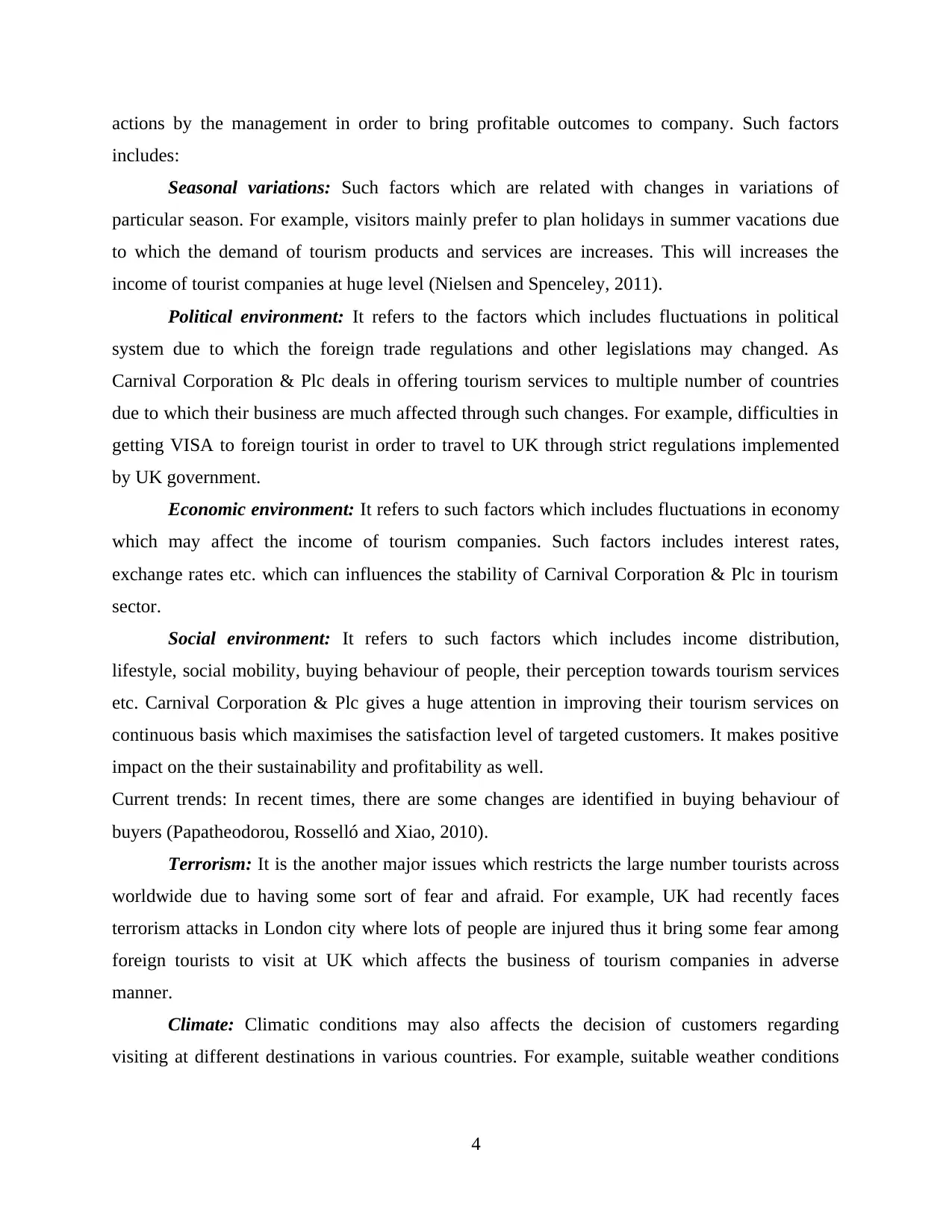
actions by the management in order to bring profitable outcomes to company. Such factors
includes:
Seasonal variations: Such factors which are related with changes in variations of
particular season. For example, visitors mainly prefer to plan holidays in summer vacations due
to which the demand of tourism products and services are increases. This will increases the
income of tourist companies at huge level (Nielsen and Spenceley, 2011).
Political environment: It refers to the factors which includes fluctuations in political
system due to which the foreign trade regulations and other legislations may changed. As
Carnival Corporation & Plc deals in offering tourism services to multiple number of countries
due to which their business are much affected through such changes. For example, difficulties in
getting VISA to foreign tourist in order to travel to UK through strict regulations implemented
by UK government.
Economic environment: It refers to such factors which includes fluctuations in economy
which may affect the income of tourism companies. Such factors includes interest rates,
exchange rates etc. which can influences the stability of Carnival Corporation & Plc in tourism
sector.
Social environment: It refers to such factors which includes income distribution,
lifestyle, social mobility, buying behaviour of people, their perception towards tourism services
etc. Carnival Corporation & Plc gives a huge attention in improving their tourism services on
continuous basis which maximises the satisfaction level of targeted customers. It makes positive
impact on the their sustainability and profitability as well.
Current trends: In recent times, there are some changes are identified in buying behaviour of
buyers (Papatheodorou, Rosselló and Xiao, 2010).
Terrorism: It is the another major issues which restricts the large number tourists across
worldwide due to having some sort of fear and afraid. For example, UK had recently faces
terrorism attacks in London city where lots of people are injured thus it bring some fear among
foreign tourists to visit at UK which affects the business of tourism companies in adverse
manner.
Climate: Climatic conditions may also affects the decision of customers regarding
visiting at different destinations in various countries. For example, suitable weather conditions
4
includes:
Seasonal variations: Such factors which are related with changes in variations of
particular season. For example, visitors mainly prefer to plan holidays in summer vacations due
to which the demand of tourism products and services are increases. This will increases the
income of tourist companies at huge level (Nielsen and Spenceley, 2011).
Political environment: It refers to the factors which includes fluctuations in political
system due to which the foreign trade regulations and other legislations may changed. As
Carnival Corporation & Plc deals in offering tourism services to multiple number of countries
due to which their business are much affected through such changes. For example, difficulties in
getting VISA to foreign tourist in order to travel to UK through strict regulations implemented
by UK government.
Economic environment: It refers to such factors which includes fluctuations in economy
which may affect the income of tourism companies. Such factors includes interest rates,
exchange rates etc. which can influences the stability of Carnival Corporation & Plc in tourism
sector.
Social environment: It refers to such factors which includes income distribution,
lifestyle, social mobility, buying behaviour of people, their perception towards tourism services
etc. Carnival Corporation & Plc gives a huge attention in improving their tourism services on
continuous basis which maximises the satisfaction level of targeted customers. It makes positive
impact on the their sustainability and profitability as well.
Current trends: In recent times, there are some changes are identified in buying behaviour of
buyers (Papatheodorou, Rosselló and Xiao, 2010).
Terrorism: It is the another major issues which restricts the large number tourists across
worldwide due to having some sort of fear and afraid. For example, UK had recently faces
terrorism attacks in London city where lots of people are injured thus it bring some fear among
foreign tourists to visit at UK which affects the business of tourism companies in adverse
manner.
Climate: Climatic conditions may also affects the decision of customers regarding
visiting at different destinations in various countries. For example, suitable weather conditions
4
Paraphrase This Document
Need a fresh take? Get an instant paraphrase of this document with our AI Paraphraser

easily attracts maximum number of tourists due to which the income of tourist companies such
as Carnival Corporation & Plc are increased.
TASK 2
2.1: Different types of management accounting information
Management accounting is a profession that involves decision making, planning and
preparing financial reports such as Profit & Loss a/c, Balance sheet, Cash flow statement etc.
which assist management in making short and long term decisions in an appropriate manner.
Gathering information from different departments help in identifying their needs and
performance level (Ritchie, Amaya Molinar and Frechtling, 2010). Therefore, to get beneficial
result the management of Dalata Hotel Group Plc follows different types of management
accounting statement in order to achieve desired goals and objectives within predetermined time
period. Some of them as given as below;
Budget report: Budget report is a prepared through estimating future business activities
so as to face no difficulties and operate business functions more successfully. It includes the
details of every tourism activities along with the estimated expenses that will be incurred while
offering to the targeted customers. It makes easy for management to deal with future challenges
through keeping sufficient amount of funds with them in advance so as to avoid any interruptions
or breakdowns. Budget statement is mostly similar to the income statement. The income and
sales are listed first preceded by the selling expenses, cost of goods sold, administrative and
general expenses etc. and at last a net operating income amount has been identified.
Financial statement: It includes Profit& Loss accounts, balance sheet, cash flow
statement etc. which shows true and fair financial position of company thus it is essential for
Dalata Hotel Group Plc to prepare such financial statements on annual basis. It is more useful to
the interest parties as well which includes creditors, investors etc. as they may show their more
interest in investing more amount after ascertaining their maximum amount of return (Ritchie,
Amaya Molinar and Frechtling, 2011).
Variance analysis: It is the report containing information regarding changes in real
behaviour against planned or forecasted behaviour in management and budgeting accounting. It
may bring difficulties towards Dalata Hotel Group Plc to offer tourism services to their clients
due to changes in their behaviour and needs. Therefore, it is necessary for company to recognise
5
as Carnival Corporation & Plc are increased.
TASK 2
2.1: Different types of management accounting information
Management accounting is a profession that involves decision making, planning and
preparing financial reports such as Profit & Loss a/c, Balance sheet, Cash flow statement etc.
which assist management in making short and long term decisions in an appropriate manner.
Gathering information from different departments help in identifying their needs and
performance level (Ritchie, Amaya Molinar and Frechtling, 2010). Therefore, to get beneficial
result the management of Dalata Hotel Group Plc follows different types of management
accounting statement in order to achieve desired goals and objectives within predetermined time
period. Some of them as given as below;
Budget report: Budget report is a prepared through estimating future business activities
so as to face no difficulties and operate business functions more successfully. It includes the
details of every tourism activities along with the estimated expenses that will be incurred while
offering to the targeted customers. It makes easy for management to deal with future challenges
through keeping sufficient amount of funds with them in advance so as to avoid any interruptions
or breakdowns. Budget statement is mostly similar to the income statement. The income and
sales are listed first preceded by the selling expenses, cost of goods sold, administrative and
general expenses etc. and at last a net operating income amount has been identified.
Financial statement: It includes Profit& Loss accounts, balance sheet, cash flow
statement etc. which shows true and fair financial position of company thus it is essential for
Dalata Hotel Group Plc to prepare such financial statements on annual basis. It is more useful to
the interest parties as well which includes creditors, investors etc. as they may show their more
interest in investing more amount after ascertaining their maximum amount of return (Ritchie,
Amaya Molinar and Frechtling, 2011).
Variance analysis: It is the report containing information regarding changes in real
behaviour against planned or forecasted behaviour in management and budgeting accounting. It
may bring difficulties towards Dalata Hotel Group Plc to offer tourism services to their clients
due to changes in their behaviour and needs. Therefore, it is necessary for company to recognise
5
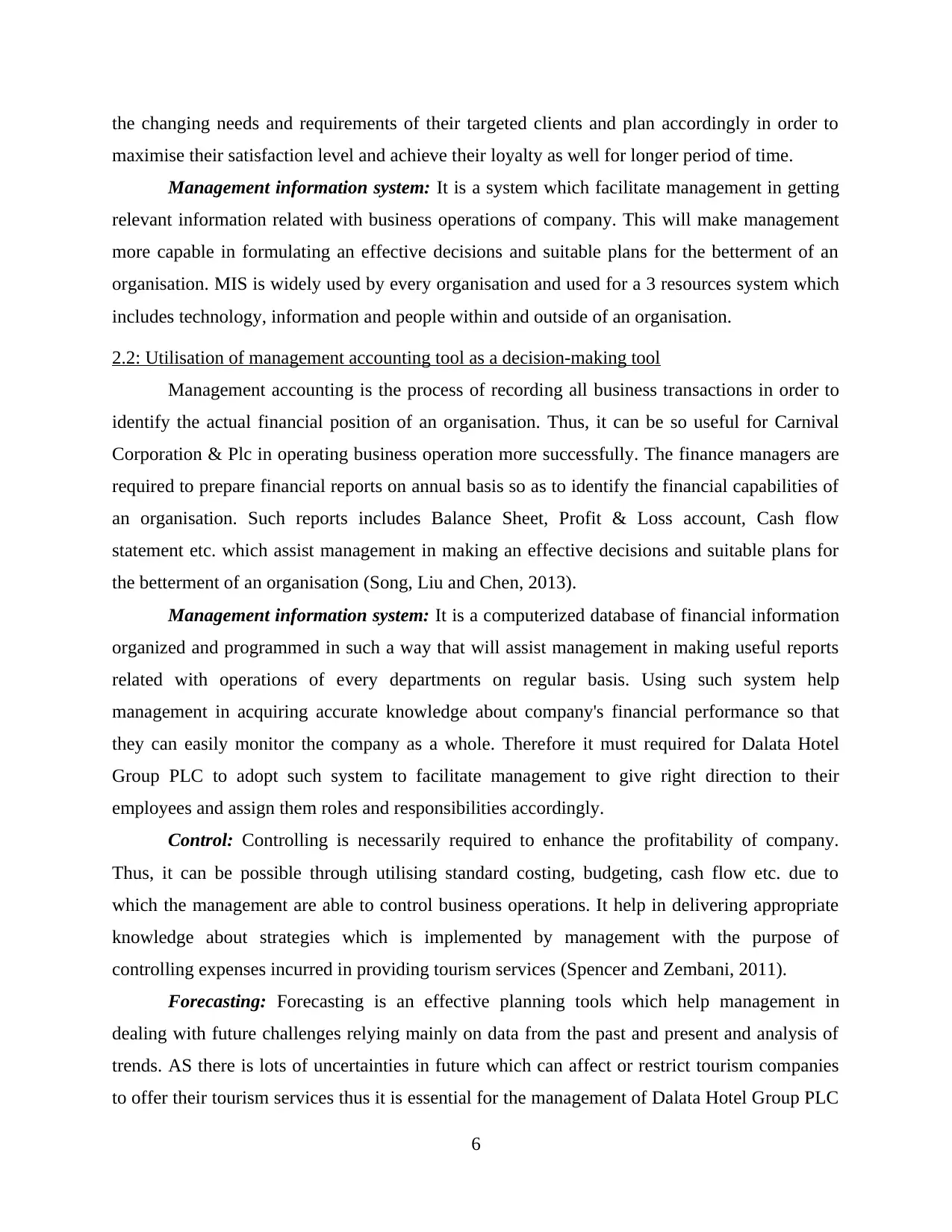
the changing needs and requirements of their targeted clients and plan accordingly in order to
maximise their satisfaction level and achieve their loyalty as well for longer period of time.
Management information system: It is a system which facilitate management in getting
relevant information related with business operations of company. This will make management
more capable in formulating an effective decisions and suitable plans for the betterment of an
organisation. MIS is widely used by every organisation and used for a 3 resources system which
includes technology, information and people within and outside of an organisation.
2.2: Utilisation of management accounting tool as a decision-making tool
Management accounting is the process of recording all business transactions in order to
identify the actual financial position of an organisation. Thus, it can be so useful for Carnival
Corporation & Plc in operating business operation more successfully. The finance managers are
required to prepare financial reports on annual basis so as to identify the financial capabilities of
an organisation. Such reports includes Balance Sheet, Profit & Loss account, Cash flow
statement etc. which assist management in making an effective decisions and suitable plans for
the betterment of an organisation (Song, Liu and Chen, 2013).
Management information system: It is a computerized database of financial information
organized and programmed in such a way that will assist management in making useful reports
related with operations of every departments on regular basis. Using such system help
management in acquiring accurate knowledge about company's financial performance so that
they can easily monitor the company as a whole. Therefore it must required for Dalata Hotel
Group PLC to adopt such system to facilitate management to give right direction to their
employees and assign them roles and responsibilities accordingly.
Control: Controlling is necessarily required to enhance the profitability of company.
Thus, it can be possible through utilising standard costing, budgeting, cash flow etc. due to
which the management are able to control business operations. It help in delivering appropriate
knowledge about strategies which is implemented by management with the purpose of
controlling expenses incurred in providing tourism services (Spencer and Zembani, 2011).
Forecasting: Forecasting is an effective planning tools which help management in
dealing with future challenges relying mainly on data from the past and present and analysis of
trends. AS there is lots of uncertainties in future which can affect or restrict tourism companies
to offer their tourism services thus it is essential for the management of Dalata Hotel Group PLC
6
maximise their satisfaction level and achieve their loyalty as well for longer period of time.
Management information system: It is a system which facilitate management in getting
relevant information related with business operations of company. This will make management
more capable in formulating an effective decisions and suitable plans for the betterment of an
organisation. MIS is widely used by every organisation and used for a 3 resources system which
includes technology, information and people within and outside of an organisation.
2.2: Utilisation of management accounting tool as a decision-making tool
Management accounting is the process of recording all business transactions in order to
identify the actual financial position of an organisation. Thus, it can be so useful for Carnival
Corporation & Plc in operating business operation more successfully. The finance managers are
required to prepare financial reports on annual basis so as to identify the financial capabilities of
an organisation. Such reports includes Balance Sheet, Profit & Loss account, Cash flow
statement etc. which assist management in making an effective decisions and suitable plans for
the betterment of an organisation (Song, Liu and Chen, 2013).
Management information system: It is a computerized database of financial information
organized and programmed in such a way that will assist management in making useful reports
related with operations of every departments on regular basis. Using such system help
management in acquiring accurate knowledge about company's financial performance so that
they can easily monitor the company as a whole. Therefore it must required for Dalata Hotel
Group PLC to adopt such system to facilitate management to give right direction to their
employees and assign them roles and responsibilities accordingly.
Control: Controlling is necessarily required to enhance the profitability of company.
Thus, it can be possible through utilising standard costing, budgeting, cash flow etc. due to
which the management are able to control business operations. It help in delivering appropriate
knowledge about strategies which is implemented by management with the purpose of
controlling expenses incurred in providing tourism services (Spencer and Zembani, 2011).
Forecasting: Forecasting is an effective planning tools which help management in
dealing with future challenges relying mainly on data from the past and present and analysis of
trends. AS there is lots of uncertainties in future which can affect or restrict tourism companies
to offer their tourism services thus it is essential for the management of Dalata Hotel Group PLC
6
⊘ This is a preview!⊘
Do you want full access?
Subscribe today to unlock all pages.

Trusted by 1+ million students worldwide
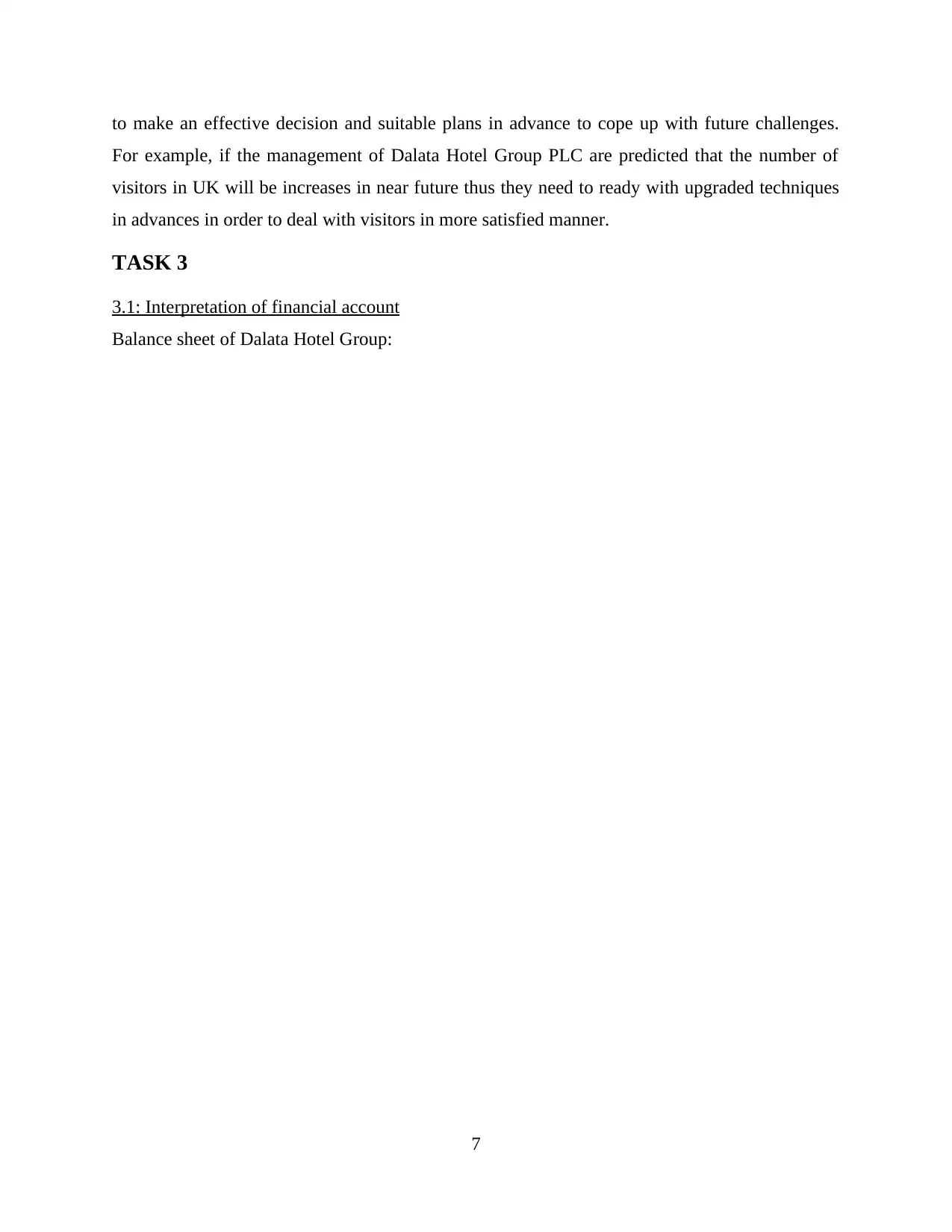
to make an effective decision and suitable plans in advance to cope up with future challenges.
For example, if the management of Dalata Hotel Group PLC are predicted that the number of
visitors in UK will be increases in near future thus they need to ready with upgraded techniques
in advances in order to deal with visitors in more satisfied manner.
TASK 3
3.1: Interpretation of financial account
Balance sheet of Dalata Hotel Group:
7
For example, if the management of Dalata Hotel Group PLC are predicted that the number of
visitors in UK will be increases in near future thus they need to ready with upgraded techniques
in advances in order to deal with visitors in more satisfied manner.
TASK 3
3.1: Interpretation of financial account
Balance sheet of Dalata Hotel Group:
7
Paraphrase This Document
Need a fresh take? Get an instant paraphrase of this document with our AI Paraphraser
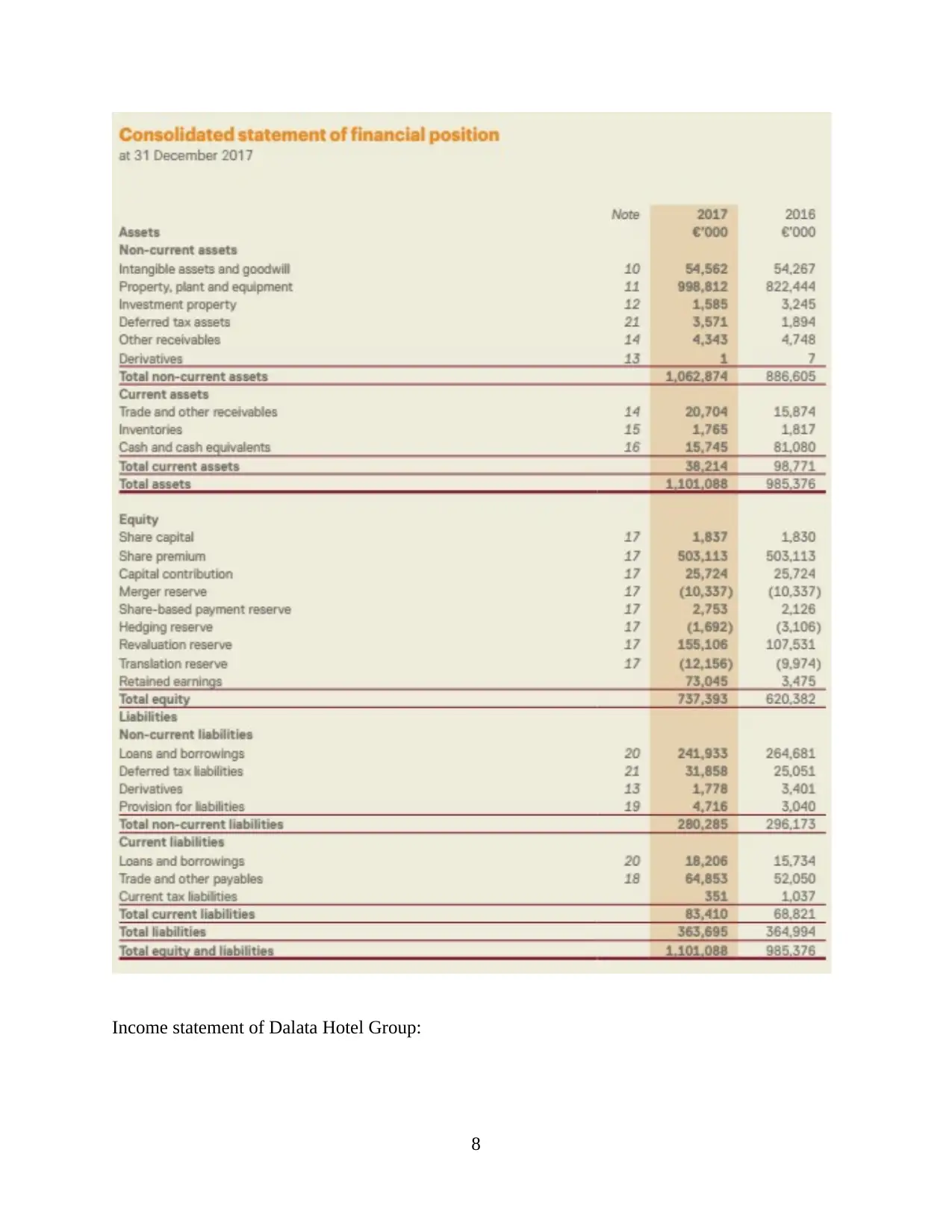
Income statement of Dalata Hotel Group:
8
8

9
⊘ This is a preview!⊘
Do you want full access?
Subscribe today to unlock all pages.

Trusted by 1+ million students worldwide
1 out of 16
Related Documents
Your All-in-One AI-Powered Toolkit for Academic Success.
+13062052269
info@desklib.com
Available 24*7 on WhatsApp / Email
![[object Object]](/_next/static/media/star-bottom.7253800d.svg)
Unlock your academic potential
Copyright © 2020–2025 A2Z Services. All Rights Reserved. Developed and managed by ZUCOL.




